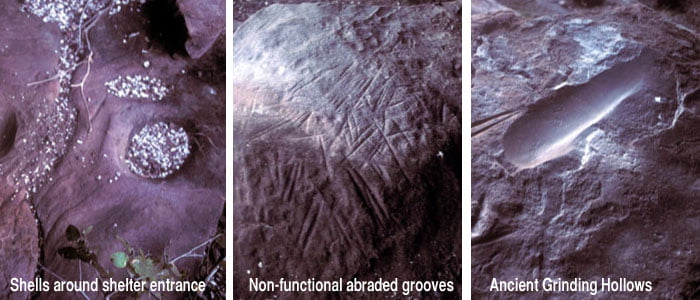The below text and images are taken and adapted from Grahame L. Walsh’s 2000 publication, Bradshaw Art of the Kimberley.
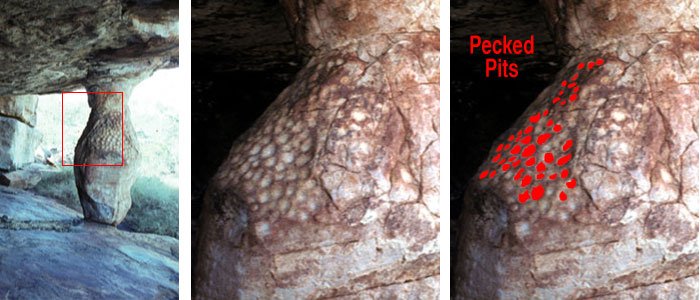
Pecked Pits
Artifical concavities, under 25mm in diameter.
Shown here is a magnificent, naturally sculptured pillar, 1730mm tall and 770x900mm along its maximum centre faces. On its upper southern ‘shoulder’ are many Pecked Pits, clustered close together, and quite deep, making a spectacular view.
Pecked Cupules
Artifical concavities, 25-80mm in diameter.
Sites chosen by Kimberley Pecked Cupule artists share a particular attribute they have floor areas suitable for at least limited forms of habitation. Loose sand is usually found at the sites, although it does not necessarily cover an extensive area.
Shown here is a section of an extensive wall panel showing various engraved application events. The low contrast and largely patinated Pecked Cupules are the earliest event, later superimposed by engraved macropod and bird tracks, which range from 200x160mm to 370x180mm. These are in turn superimposed by a quite recent event involving ‘retouch’ to ancient motifs of both preceding events, converting their surfaces again to high contrast. In this phase, the artists of the far eastern Kimberley and far north-west Northern Territory created ordered patterns of pecked cupules, or selectively modified existing cupules to attain this visual effect, as is evident in the upper area of this panel.
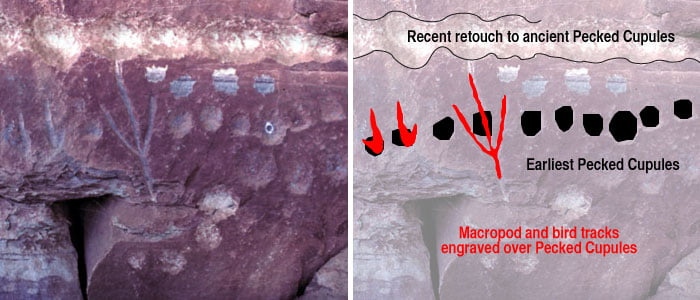
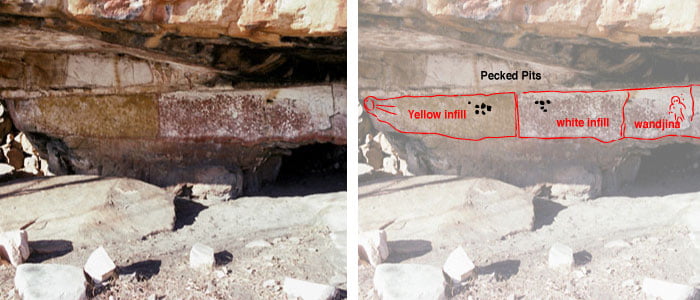
Generally, it could be said that artists of the Pecked Cupule Period shared site location requirements common to those of the Irregular Infill Animal Period and the recent Wanjina Period.
In this site, late afternoon sun highlights a section of a Grand Panel of Pecked Cupules now covered beneath dense layers of repainted art in a Cathedral Class regional Wanjina gallery. The polychrome overlying painting is a 290x2200mm horizontal Wanjina sugarbag (native bee hive) painting.
On the pecked surface areas not overpainted are thick layers of oxalate buildup, the pits appear to be of great antiquity.
A panel of patinated ancient Pecked Pits are on a large separated block. A huge ceiling block has collapsed and fallen down over them, and it is on a ‘ceiling’ area of this that a Horseshoe Head Figure is painted, together with numerous other figures, including a clear brown 3890x120mm later ‘Bradshaw’, indicating that these all postdate the Pecked Pits.
This collapsed rock offers a rare opportunity to provide a minimum date for these pecked cupules.
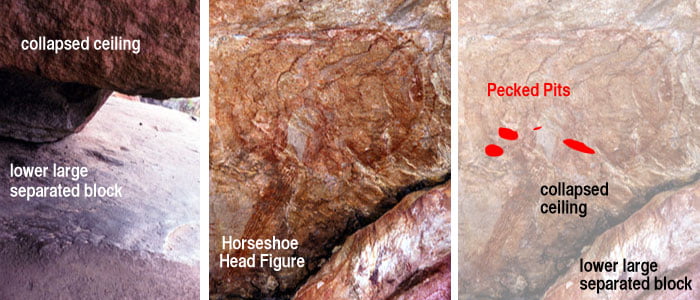
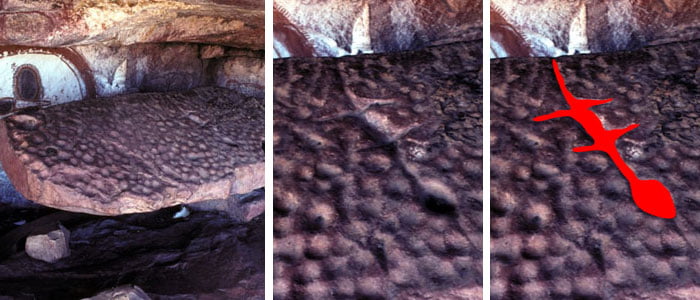
Prebraded Cupules
Formed by pecking and abrasive polishing.
This is an example of Pebraded Cupules concentrated on an unusually shaped 1840x620mm natural rock slab. One of the rare examples of abraded figurative motifs, apparently directly related to Pecked Cupule art, can be seen in the middle of the concentration, and detail of the ‘lizard-like’ motif is shown.
In some sites, unusually shaped natural rock slabs, outcrops and boulders have been the subject of concentrated Pebraded Cupule activity, whereas the remainder of the often spacious shelters remain untouched.
In the recent Wanjina Period, this site has been recycled as a major Basilica Class regional Wanjina gallery, and the slab decorated by the early culture has been used as a platform for multiple cached burials. Plate photos of 1901 show the gallery with masses of vegetation stacked on the slab to act as bedding for the burials. This has long since deteriorated, and the burial remains have been scattered.
Grinding hollows and abraded grooves
The most logical explanation for the lack of availability of seed resources would seem to be climatic change. The best documented and most recent major climatic change is associated with the Last Glacial Maximum, 18,000–20,0000BP, and as geological attributes of these abandoned surfaces show seed preparation was a local practice linked to archaic times, these activities presumably predate that time.
In this and similar sites, evidence of sea shells littering the surfaces of site floor and approach areas confirms that the use of marine resources as an important food persisted into historical times. Use of such resources could only have been possible during the last 6000–8000 years, when rising sea levels advanced the shore line hundreds of kilometres inland. Seed gathering and preparation practices are time and labour-intensive, and are recognised as unavoidable prerequisites for the survival of significant populations, particularly in low-resource environments common to the arid inland. However, marine resources provide a more efficient ratio of energy expended to resource acquisition, so the change of focus and activities was a logical development when rising sea levels provided this option. These examples of rock surface modification suggest that this process continued into historical times.
The above text and images are taken and adapted from Grahame L. Walsh’s 2000 publication, Bradshaw Art of the Kimberley.
